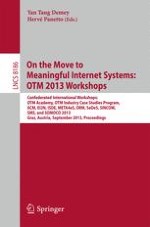This volume constitutes the refereed proceedings of the international workshops, Confederated International Workshops: OTM Academy, OTM Industry Case Studies Program, ACM, EI2N, ISDE, META4eS, ORM, SeDeS, SINCOM, SMS and SOMOCO 2013, held as part of OTM 2013 in Graz, Austria, in September 2013. The 75 revised full papers presented together with 12 posters and 5 keynotes were carefully reviewed and selected from a total of 131 submissions. The papers are organized in topical sections on: On The Move Academy; Industry Case Studies Program; Adaptive Case Management and other non-workflow approaches to BPM; Enterprise Integration, Interoperability and Networking; Information Systems in Distributed Environment; Methods, Evaluation, Tools and Applications for the Creation and Consumption of Structured Data for the e-Society; Fact-Oriented Modeling; Semantics and Decision Making; Social Media Semantics; Social and Mobile Computing for collaborative environments; cooperative information systems; Ontologies, Data Bases and Applications of Semantics.
